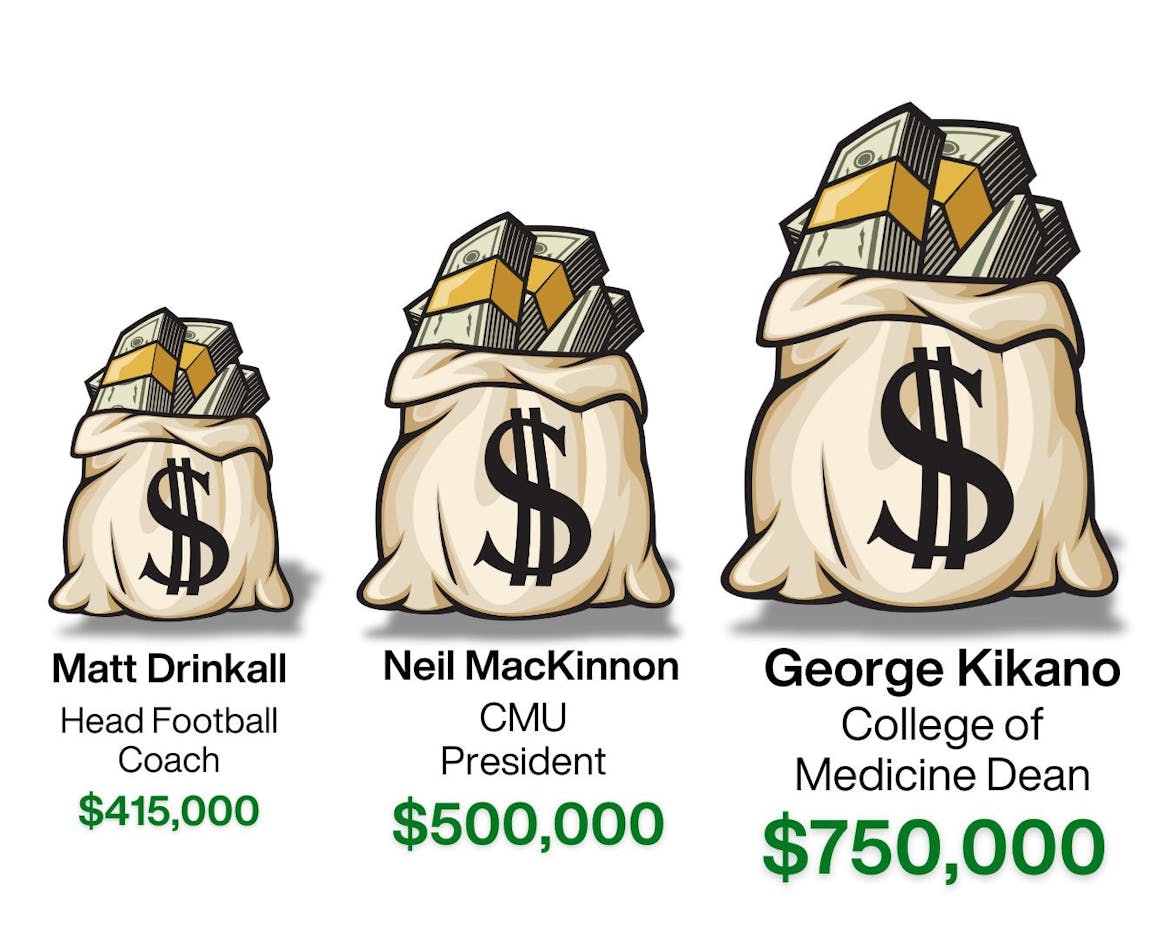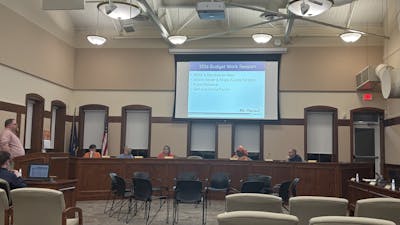Personnel values
A look at how CMU determines salaries
In any workplace, the employees of that company must get paid. Each of these people have value - both personal value and market value.
At Central Michigan University, the collective value of the campus faculty and staff in 2024 -- from the president to the part time janitor -- was $171 million, which is 38% of the total operating budget.
But how is that money divided by departments, and who is getting the biggest pieces of the monetary pie?
The top paid employees at CMU
According to a Freedom of Information Act request provided by CMU, the former dean of CMU’s College of Medicine, George Kikano, was the university's highest-paid employee before he resigned on March 6, with a base salary of $750,000. He began his role as dean in 2015 and was appointed to other positions, such as executive vice president for Health Affairs and chair of the board for CMU Medical Education Partners.
Earlier this semester, Kikano announced he was stepping down from his role at the university. This sudden transition halted any plans for external health partnerships for campus clinics, according to the university.
President MacKinnon is the second highest-paid employee at CMU, with a base salary of $500,000 a year.
Here are the other top-paid employees at CMU as of March 2025 (base salaries):
- Head Football Coach Matt Drinkall - $415,000
- Professor and the Senior Associate Dean of Research Sethu Reddy - $389,717
- Associate Dean of Clinical Education Steven Vance - $356,879
- Provost Paula Lancaster - $350,000
- Former Head Men’s Basketball Coach Tony Barbee - $346,794
- Vice President & Chief Financial Officer Mary Moran Hill - $319,268
- Zyzelewski Family Associate Vice President and Director of Athletics Amy Folan - $309,638
Director of Employment and Compensation Cali Clark said that salaries are calculated using CMU’s Compensation Philosophy, which outlines that starting salaries are based on factors such as individual qualifications, internal equity with current employees and the external market of university employment.
Some external markets, Clark said, include national universities, Michigan universities, Mid-American Conference (MAC) universities and peer institutions. After these comparisons, she said HR recommends a salary range to the departments.
“It's not an exact science,” she said. “There's no exact formula … we take all of those things into consideration when we're making a recommendation.”
The University of Toledo is one of the several schools CMU compares salaries with. Here are the salaries of similar positions:
- Executive Vice President of Health Affairs - $700,000
- Dean of the College of Medicine - $550,000
- President – Interim President - $525,000
- Head Football Coach - $575,000
- Senior Associate Dean of Research - Interim VP for Research - $222,697.33
- Provost/Executive Vice President – Interim Provost - $357,000
- Vice President of Finance and Administrative Services/Chief Financial Officer – Interim VP of Finance - $192,499.97
- Director of Athletics - $312,120

The average salary of CMU's salary list
CMU annually releases a list of salaries for different employee groups on campus. The salary list includes nearly every employee’s base salary other than senior officers such as college deans, associate deans and other higher administrative positions.
Here are the averages of each group listed in the CMU 2024-25 Salary List:
- Dispatchers - $54,065 (6 employees)
- Faculty - $91,677 (755 employees)
- Service/Maintenance - $42,803 (164 employees)
- Medical Faculty - $155,859 (39 employees)
- Office Professionals - $39,370 (223 employees)
- Police Officers - $89,970 (7 employees)
- Doctoral Research - $54,245 (14 employees)
- Professional and Administrative - $69,055 (791 employees)
- Public Broadcasting - $53,747 (25 employees)
- Supervisory/Technical - $46,346 (86 employees)
The entire list has a total of 2,114 employees, and the average salary of all of these positions comes to $72,406.
“A university is more like a small city than a single company, and it takes a wide range of people with a tremendous variety of knowledge, backgrounds and experiences to function properly,” Executive Director of University Communications Ari Harris wrote in an email to Central Michigan Life on May 1. “We’re very fortunate to have highly qualified, experienced, passionate faculty and staff who choose to share their talents with our university community.”
Breaking down faculty pay
In 2023-24, there were over 900 faculty members working at the university in different departments with varying pay and benefits. Amanda Garrison is a tenured professor in the sociology department, as well as the president of the CMU Faculty Association. She said the differences in pay and benefits between professors is attributed to two things: Which of the eight colleges they work in, and whether they are fixed-term or tenure-tracked.
Garrison said that the university used to follow a Responsibility Centered Management Model, or RCM Model. This model made it so each college was in charge of its own funding, and their funding was determined entirely by how many students were enrolled in each.
For example, the College of Medicine and College of Business have the most students and most demand, so their professors are paid more, while the College of Arts and Media and the College of Education and Human Services see fewer students, so professors are paid less in comparison.
“Capitalism determines to some extent how we're (the colleges and what they teach) valued as sciences,” Garrison said. “Those professors (in business) are often also valued because they're professionals in the world, too. ... They're always also going to have more students.
“It should also make sense that health professions would have more money allocated to them, given the number of students they have (and) given the meaning of what they produce and provide, so doctors ... have a higher value because of what they can produce and provide.”
Additionally, Garrison explained that tenured and fixed-term professors are paid differently.
She said tenured professors are usually paid double the salary of fixed-term, and that they have job security as long as they're actively pursuing research milestones.
She said tenured faculty receive support from their deans to reach their research goals, and their expectations are clearly outlined, as compared to other institutions.
“We have these checkpoints in place to make sure that you get where you wanna be,” she said.
Tenured professors also have benefits such as healthcare, sick days, bereavement days and salary increases each year. Garrison said in the event of misconduct, the university will offer training courses and work with the professors to correct it.
“Even if you do something that's so awful to a student that's not against the law, that's just against policy, you still get training,” Garrison said. “You go through a process. If it doesn't take and you keep doing it, you'll still get it (training). They're going to try and try because they don't want to get rid of you.”
In comparison, she said that fixed-term professors have jobs based on a contract, and their job security is based on whether that contract gets renewed. She said that fixed-term tends to teach more classes than tenure, and if a college goes through budget cuts, they are the first to be fired. She also said that they have little-to-no benefits.
“I think I've heard that they might bring (fixed-term) people in at like $32,000 maybe,” Garrison said. “And coming in now, I think as an assistant, people are making $75,000 to $80,000. Think about that difference. That's a whole person's salary.”
Garrison said that this disparity leads to grievances across departments. She said that the faculty members should not argue over benefits, but should instead work together to achieve the same benefits and support.
“There's tension between us because we're encouraged to look at each other and say, ‘You have more than I do,’” she said. “‘Why do you have more than I do? My work is just as valuable as yours.’ That's not the place to look. What we have to do is help each other turn around and look back over (at the top)."
“This is the problem, not us. If you aren't getting what you need, we need to stand with you and make sure you get what you need. Not that we give up what we have. You need what we have.”

* Related content: 'Past Deadline: A look at CMU salaries'
Other aspects of employment
Outside of the roughly 900 faculty members CMU employs, the university also employs around 1,160 staff members in other employee groups.
Hiring, compensation, benefits and internal promotions of these employees are all handled through CMU’s Human Resources. Clark said that while HR doesn’t conduct the interviews or onboarding processes for new hires, they do handle some of the more technical aspects of hiring, such as conducting background checks, approving candidates, disciplinary action and more.
Clark said that throughout the hiring process, departments communicate with HR to approve candidates and negotiate salaries and benefits once hired.
Alongside hiring, Clark said the HR office handles other issues, such as concerns with supervisors, medical leave, worker’s compensation claims and coaching and training opportunities. She said the trainings, as well as having to terminate employees, is the hardest part of her job.
“Some of the more difficult pieces (of the job) is when a department wants to go through a reorganization and maybe it results in a layoff for an employee or an employee isn't performing (well),” she said. “They have to sit down and coach them or talk with them about that sometimes. They see that as a difficult time when we're really trying to help them.”
Clark also said the university has seen issues with retention in recent years, especially when the COVID-19 pandemic happened. She cited that in 2020, CMU had a turnover rate of 14.6%, and in 2021 there was a turnover rate of 18.2%, with 250 faculty and staff members leaving their positions. While the numbers have been declining since (in 2024 it was down to 13.7%), she said it still proves difficult for the university.
“There’s a very difficult employment market right now, where individuals are always looking for the next best thing,” she said. “They might come in and only stay for a year and then they go off because there's so many job openings and opportunities for individuals. If they're wanting to increase their pay and that's the number one priority for them, they might be looking for other jobs outside of the university.
"That's frustrating, to spend time and money and go through the process of hiring someone and not being able to retain them, but we're hopeful that CMU is a different culture, where ... you're wanting to stay.”







